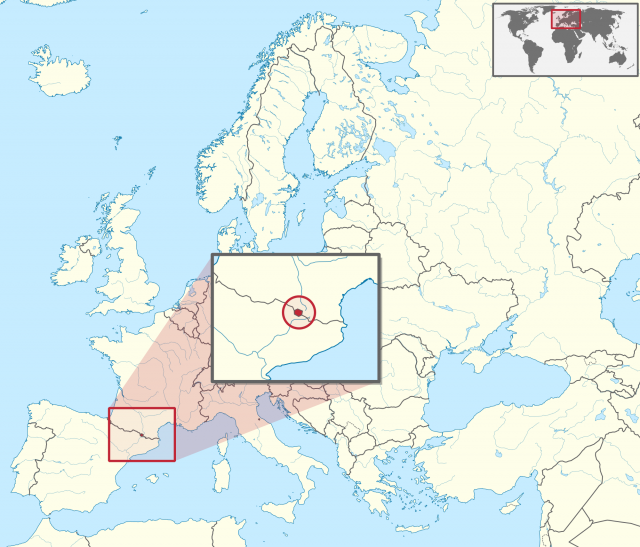Andorra
Area 183 square mi (468 square km)
Capital Andorra la Vella
Population 80,150 2014
Highest Point 9,722 ft (2,946 m)
Lowest Point 2,772 ft (840 m)
GDP $3.249 billion 2013
Primary Natural Resources hydropower, timber.
ONE OF THE WORLD'S true curiosities, the sovereign coprincipality of Andorra retains independent status which, according to local history, was granted in the 9th century by Charlemagne for the people's valiant services to him against the Moors. Consisting of the upper valleys of the river Valira, this tiny country is nestled among the high mountain passes of the Pyrenees between FRANCE and SPAIN. Only 2.5 times the size of Washington, D.C., it is one of the smallest countries in the world. What makes Andorra truly curious, however, is it's unusual status as a coprincipality, though without a local prince; instead, it is governed jointly by the republic of FRANCE and by the Bishop of Urgell, a small town a few miles to the south in Spain. The French president and the bishop act as coprinces only nominally, however, and since 1993 the country has been entirely sovereign and self-ruling.

PEAKS AND VALLEYS
Andorra is located between the French department of Ariege, in the region of Midi-Pyrenees, and the Spanish province of Lerida (or Lleida) in the region of Catalonia. Consisting of high mountain peaks and narrow valleys, the elevation of Andorra ranges from 6,500 to 10,000 ft (2,000 to 3,000 m). The climate is fairly severe, restricting vegetation to minimal mountain scrub: One suggestion of the origin of the name Andorra, is that it comes from a local term for “shrub-covered.” But this climate provides excellent high mountain pastures for sheep and cattle and is also a great attraction for skiers from all over Europe. The economy runs mostly on tourism, with numerous summer and winter resorts, and also as a duty-free shopping center. Much of Andorra remains rural. Most of its inhabitants live in one of six main villages, raise their herds of sheep or cattle, and manage small farms, raising rye, wheat, barley, oats, and vegetables. There are also some fruit orchards and vineyards. Most of the population lives in and around the capital, Andorra la Vella, where there is some light manufacture, notably cigarettes, sandals, and anisette liqueur.
The coprincipality has been jointly ruled since a treaty in 1278 between the Count of Foix and the Bishop of Urgell. At that time, there were several small states between France and Spain; the unusual thing is that this one survived into the 21st century. The pass of Port d'Envalita (7,943 ft or 2,407 m) has served as a major route between Toulouse, France, and northern Spain since ancient times. While the status of the bishop remained the same, the Counts of Foix eventually died out and the title was absorbed by the king of France in the 17th century. After the French Revolution, the post naturally fell to the president of the republic. In 1993, Andorrans voted in favor of a new constitution that, while retaining the honorific position of the coprinces, gives Andorra complete sovereignty and control over its affairs, both internal and external. It has been a member of the EUROPEAN UNION (EU) since 1990, uses the euro, and became a full member of the United Nations in 1994. But Andorra's position as a free-port also brings with it the associated problems of smuggling and money laundering, the subject of an accord settled between the five European microstates and the EU in 2003.